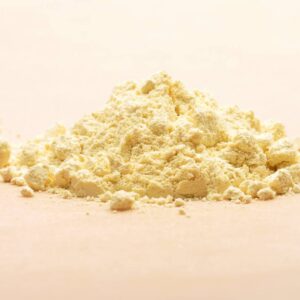For years, European livestock farming has been hooked on one thing: soybean. It’s the go-to protein source for animal feed, but this reliance comes at a cost. The vast majority of soybean is imported, leaving European farmers vulnerable to the whims of global trade, price fluctuations, and the environmental impact of long-distance shipping.
But what if there was a local, sustainable alternative that could break this dependency and boost European agriculture? Enter the lupin bean – a nutritional powerhouse that’s been quietly gaining attention as a potential game-changer.
The Soybean Problem: Why Europe Needs a Plan B
Europe’s appetite for meat and dairy is huge, and that demand fuels a massive need for animal feed. Soybean has become the dominant source of protein in that feed, thanks to its high protein content and availability. However, this comes with significant drawbacks:
Import Dependence: The EU imports most of its soybean, making it vulnerable to global market shifts and trade disruptions.
Environmental Concerns: Soybean production is linked to deforestation in some parts of the world, raising serious environmental concerns.
GMO Concerns: Many consumers are increasingly wary of genetically modified (GM) crops, and finding non-GM soybean can be difficult and expensive.
The EU recognizes this imbalance and is actively seeking ways to promote the cultivation of protein crops within Europe. This push is driven by economic, environmental, and social factors, as consumers demand more sustainable and ethical food production.
Lupin: The Little Bean That Could
Lupin beans, members of the Lupinus genus, are legumes with a rich history. They’ve been cultivated for centuries in the Mediterranean region and the Andes, used for everything from green manure to food. What makes them so special?
High Protein Content: Lupin beans boast a protein content comparable to soybean, making them an excellent alternative for animal feed.
Nitrogen Fixation: Like other legumes, lupins have a symbiotic relationship with Rhizobium bacteria, allowing them to fix atmospheric nitrogen in the soil. This reduces the need for synthetic nitrogen fertilizers, which are energy-intensive and can contribute to environmental problems.
Versatility: Lupins can be used as both a concentrate (seeds) and forage (plant material) in animal diets.
Lupin vs. Soybean: A Nutritional Showdown
When it comes to animal nutrition, lupins hold their own against soybean. Here’s a closer look at the nutritional value of different lupin species:
| Nutrient | L. albus | L. angustifolius | L. luteus | L. mutabilis |
|---|---|---|---|---|
| Crude Protein (% DM) | 33-47 | 31-37 | 37-38 | 32-52 |
| Crude Fiber (% DM) | 13-16 | 15-17 | 12-15 | 10 |
| Oil (%) | 6-13 | 6-7 | 5-9 | 13-24 |
As you can see, lupins offer a comparable protein content to soybean. They also contain essential amino acids, although they may be slightly lower in sulfur-containing amino acids. Lupin oil is generally low, except for L. mutabilis, but it’s rich in unsaturated fatty acids, which are beneficial for animal health.
Addressing the Challenges: Alkaloids and Breeding
While lupins have enormous potential, there are some challenges to overcome:
Alkaloids: Wild lupin beans contain quinolizidine alkaloids, which give them a bitter taste and can be toxic at high levels. However, modern cultivars have been bred to contain very low levels of alkaloids, making them safe for animal consumption.
Antinutritional Factors: Lupin beans contain non-starch polysaccharides (NSP) and raffinose oligosaccharides, which can affect energy utilization and digestibility, especially in monogastric animals like pigs and poultry. Processing methods like grinding and heating can help reduce these factors.
Yield: Lupin yields can be variable and are often lower than soybean yields. However, breeding efforts are focused on improving yield stability and adaptability to different environments.
Breeding for Success: The Future of Lupin Cultivation
Lupin breeding programs are crucial for unlocking the full potential of this crop. Breeders are working to develop cultivars with:
Higher and more stable yields
Resistance to diseases and pests
Tolerance to abiotic stresses like drought and poor soils
Improved seed quality and nutritional value
Lower alkaloid content
Modern genomic tools, such as marker-assisted selection, are accelerating the breeding process and allowing breeders to identify and select for desirable traits more efficiently.
Lupin in the Livestock Farming System: A Win-Win Scenario
Incorporating lupins into livestock farming systems offers numerous advantages:
Reduced Import Dependence: By replacing imported soybean with locally grown lupins, Europe can reduce its reliance on global markets and support its own farmers.
Sustainable Agriculture: Lupin cultivation promotes sustainable agriculture through nitrogen fixation, reduced fertilizer use, and improved soil health.
Improved Animal Welfare: Non-GM lupin feed can meet the growing consumer demand for more ethical and sustainable animal products.
Economic Benefits: Lupin production can create new economic opportunities for farmers and rural communities.
From the Field to the Feed: How Lupins Are Used
Lupin beans can be used in a variety of ways in animal feed:
Whole seeds: Can be fed directly to animals, either whole or crushed.
Ground seeds: Ground lupin seeds can be incorporated into feed mixes.
Processed seeds: Various processing methods, such as heating and extrusion, can improve the digestibility and nutritional value of lupin seeds.
Forage: Lupin plants can be used as forage for ruminant animals.
Lupin: A Key to Sustainable European Agriculture?
Lupin beans offer a promising solution to Europe’s soybean dependency and the challenges facing its livestock farming systems. By investing in lupin breeding, promoting sustainable cultivation practices, and supporting the development of lupin-based animal feed, Europe can create a more resilient, sustainable, and ethical agricultural sector.
It’s time to give this humble bean the attention it deserves and unlock its potential to transform European agriculture. The reign of soybean might just be coming to an end.
Based on the original research paper: https://pmc.ncbi.nlm.nih.gov/articles/PMC6413129/






